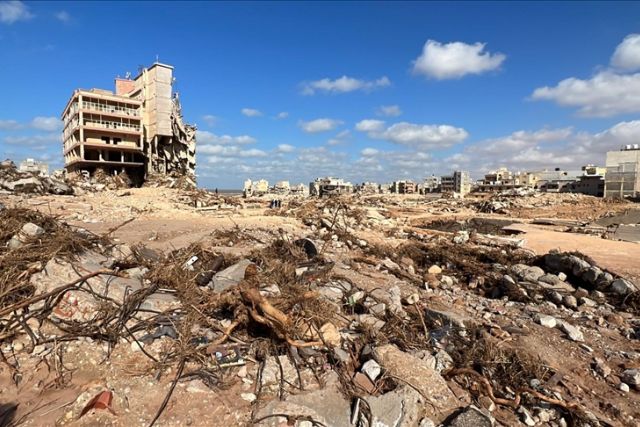Months of devastation: World battered by rising number of natural catastrophes
Libya could have avoided such a high number of casualties, material damage if there was an effective early warning system, says expert

ANKARA
The year 2023 has witnessed all types of natural disasters which keep increasing both in terms of their numbers and severity, making it the year of natural catastrophic events, according to an expert.
From earthquakes, wildfires and droughts to floods, landslides, cyclones, and storms, 2023 has been a catastrophic year by surpassing the statistics of previous years.
Anadolu compiled the most devastating natural disasters that occurred in the last two months across the world, as they seem to have radically increased in this period.
Drought
Lacking sufficient rainfall in the first half of 2023, Sri Lanka faced a drought in August.
This left 150,000 people in 10 districts of the country without access to safe drinking water, said ReliefWeb, a humanitarian information service provided by the UN Office for the Coordination of Humanitarian Affairs (OCHA), quoting the National Disaster Relief Service Centre (NDRSC).
The situation negatively impacted the lives of almost 50,000 farmers, it added.
Wildfires
Greece faced a wildfire which its northeastern Evros region declared the biggest in the last 20 years as it had been raging for about two weeks.
The fire, which broke out on Aug. 19, gradually burned over 292,587 hectares (722,998 acres) of forest area which was said to be larger than New York City, according to the European Commission.
The Athens administration blamed arsonists for the Evros wildfire and others, which were spurred by strong winds and high temperatures.
The bodies of 20 people who had burned to death, including two children, were found in the Dadia forest in Evros due to the wildfire.
A wildfire in Spain broke out on Aug. 15 and scorched around 10,000 hectares (24,710 acres). Authorities said it was the worst on record for the Canary Islands.
A government official initially said that more than 26,000 people had been evacuated from their homes, but the figure was later revised to 12,600.
Canada meanwhile has seen a record number of wildfires so far this year, with 5,500 wildfires consuming 13.4 million hectares (33.1 million acres) as of the beginning of August as officials warned there is “significant fire activity” still to come.
There had been 211 evacuation orders and more than 167,000 people had been forced to leave their homes, said officials.
In late August, northwestern and central parts of Türkiye were the scenes of serious wildfires that injured seven people with no life-threatening conditions, according to the Turkish Disaster and Emergency Management Presidency (AFAD).
Nearly 4,080 hectares (10,081 acres) of land were affected, including about 2,650 hectares (6,548 acres) of forest and 1,430 hectares (3,533 acres) of agricultural land and other areas, officials said.
In addition, the US state of Hawaii suffered an unimaginable tragedy in August when a wildfire destroyed the historic town of Lahaina.
At least 115 people lost their lives in the disaster, which caused the evacuation of over 1,400 residents to shelters.
US President Joe Biden issued a major disaster declaration for the island of Maui, where Lahaina is located, for what has become one of the worst natural disasters in Hawaii's history.
Forest fires also broke out in Algeria in July and burned for weeks, leaving over a dozen casualties according to the country's Interior Ministry.
Earthquake
Morocco was jolted on Sept. 8 by a magnitude 7 earthquake which claimed at least 2,901 lives while leaving 5,530 others injured.
Work by search and rescue teams is underway and the country has been receiving aid from Spain, the UK, Qatar, and the United Arab Emirates, according to the Moroccan Interior Ministry.
The quake was the strongest to hit the North African country in a century, according to Morocco's National Geophysical Institute.
Floods, landslide
Heavy rains that began on the night of Aug. 3-4 in Slovenia caused severe floods and landslides in western, northern, eastern and central parts of the country, according to ReliefWeb.
The disaster affected two-thirds of the country, killing at least six people and leaving hundreds homeless.
In Bangladesh, floods occurred due to heavy rains that started at the beginning of August.
The flash floods washed away hundreds of houses, submerged 5,000 hectares (12,355 acres) of crop fields and fish farms and damaged vast stretches of roads in coastal Cox's Bazar.
According to the Ministry of Disaster Management and Relief, over one million people have been affected.
Guinea meanwhile has been experiencing persistent torrential rains since the beginning of August, said ReliefWeb.
“The areas affected by the floods have already been experiencing acute humanitarian needs due to economic hardship and financial instability,” it noted.
In Vietnam, floods and landslides triggered by heavy rains since Aug. 2 in the country's northern mountainous region resulted in causalities and damage, according to ReliefWeb.
It said that 12 people were killed and five others were injured while three others are missing.
At least 104 houses were damaged in Lao Cai City and Bao Thang District in central Lao Cai Province.
“A total of 30,000 people have been affected and 2,940 people have been displaced and are sheltering in safer locations,” it added.
Kyrgyzstan also experienced floods and mudflows due to short-term rains in its northeastern Issyk-Kul region.
The Ministry of Emergency Situations and local authorities reported that “200 households were directly impacted by the disaster, however, preliminarily, 60% of the total population (13,000 people) of the five affected villages are in need of assistance of various degrees,” said ReliefWeb.
Storm, cyclone
The Latin American region experienced similar natural disasters, with an extratropical cyclone bringing heavy rainfall, strong winds and hailstorms in Brazil since Sept. 4.
“The severe weather has affected at least 340,928 people across 93 municipalities, leaving 46 people dead, 46 people missing and 924 injured,” said ReliefWeb.
“Some 3,130 people have been rescued, while 20,498 residents have been displaced and a further 4,794 have been left homeless,” it noted.
Greece meanwhile was impacted by multiple natural disasters in the last two months as Tropical Storm Daniel added to the country's suffering after facing massive wildfires.
The storm brought record-breaking rainfall on Sept. 5-6 “with a reported 750 mm falling in 24 hours at a station in the village of Zagora,” said ReliefWeb.
In Libya, Storm Daniel made landfall on Sept. 10, “causing severe weather conditions, including strong winds and sudden heavy rainfall affecting several northeastern areas” across the country, it said.
At least 6,000 people were killed and thousands of others remain missing due to the weekend floods in eastern Libya, according to officials.
Torrential rains swept several regions, most notably the cities of Derna, Benghazi, Al-Bayda, Al-Marj and Soussa.
Countries and international organizations have been sending humanitarian aid to the flood-hit country.
Absence of early warning systems?
Murat Turkes, a member of the Board of Directors of Türkiye's Bogazici University Climate Change and Policy Implementation and Research Center, told Anadolu that the world has been experiencing much more natural disasters in the last couple of years.
He defined 2023 as "the year of natural disasters."
Underscoring the rise in the number and severity of natural disasters worldwide in the last two months, he pointed to studies by the World Meteorological Organization (WMO), which demonstrate that “there is a very serious upward trend in recorded droughts, extreme temperatures, floods, mass movements, landslides, storms and wildfires.”
Criticizing the effectiveness of early warning systems by using the Libya case as an example, Turkes asserted that “we all saw that those are all on paper.”
“Together with human-caused climate change, that is, with global warming, it seems that these important disasters will increasingly be more effective both in the world and in Türkiye, both in terms of intensity and the socio-economic negative consequences they create,” he said.
Calling the 2023 summer “extraordinary,” as July has been the hottest month of all years to date, he underscored that one of the global warming targets of the Paris Treaty --1.5C -- has also been passed.
In addition, regarding the heavy rains, record-breaking rainfall and floods, he said: “The most, largest and fastest drops of rain and hail fall per unit area per unit time, and if the infrastructure is not sufficient, if there is no serious disaster management or early warning systems -- as in Libya, for example -- thousands of people can lose their lives in a flood, as if there had been an earthquake.”
It is all the same for both the world and Türkiye regarding the statistics, he emphasized.





